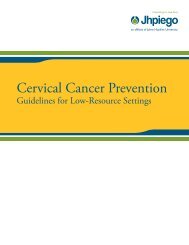Manual for Male Circumcision under Local Anaesthesia
Manual for Male Circumcision under Local Anaesthesia
Manual for Male Circumcision under Local Anaesthesia
Create successful ePaper yourself
Turn your PDF publications into a flip-book with our unique Google optimized e-Paper software.
<strong>Male</strong> circumcision <strong>under</strong> local anaesthesia<br />
Version 3.1 (Dec09)<br />
Keep in mind the following:<br />
• Alcohol-based handrubs do not remove soil or organic matter. If hands<br />
are visibly soiled, wash them with soap and water.<br />
• Staff who frequently wash hands or use an alcohol-based handrub should<br />
use hand lotions and creams regularly to minimize drying of the skin and<br />
reduce the risk of irritant contact dermatitis. Staff with an allergy or<br />
adverse reaction to alcohol-based handrubs should use other handrubs or<br />
soap and water.<br />
If potentially infectious blood or other body fluid is splashed onto non-intact<br />
skin, or if there is a potentially infective percutaneous injury, do not use<br />
alcohol-based solutions or strong disinfectants; wash the affected part with<br />
water and soap, and seek advice on the need <strong>for</strong> post-exposure prophylaxis<br />
(PEP) (see page 8-16).<br />
Surgical hand scrub<br />
The hand scrub procedure <strong>for</strong> the surgeon is described in Chapter 4.<br />
PERSONAL PROTECTIVE EQUIPMENT<br />
Personal protective equipment provides a physical barrier against<br />
microorganisms, helping to prevent them from contaminating hands, eyes,<br />
clothing, hair and shoes, and from being transmitted to patients and staff.<br />
Personal protective equipment includes gloves, masks, protective eyewear<br />
(face shield or goggles), cap or hair cover, apron, gown, and footwear (boot<br />
or shoe covers).<br />
Personal protective equipment should be used by health care workers who<br />
provide direct care to patients, support staff, including medical aides,<br />
cleaners, and laundry staff, and family members who provide care to patients<br />
in situations where they may have contact with blood, blood products and<br />
body fluids. Laboratory staff who handle patient specimens should always use<br />
personal protective equipment.<br />
Protective equipment that is designed <strong>for</strong> single use (e.g. disposable gloves,<br />
eyewear, masks, caps, gowns, aprons and footwear) should not be reused. It<br />
should be disposed of according to the health care facility protocol. Reusable<br />
equipment should be decontaminated according to the manufacturer’s<br />
instructions or la<strong>under</strong>ed according to the health care facility protocol.<br />
Gloves<br />
The use of gloves does not replace the need <strong>for</strong> hand hygiene by either hand<br />
rubbing or hand washing. Gloves should be worn whenever the person is<br />
likely to come into contact with blood or other potentially infectious materials,<br />
mucous membranes, or non-intact skin. Gloves should be removed<br />
Prevention of Infection Chapter 8-7
















